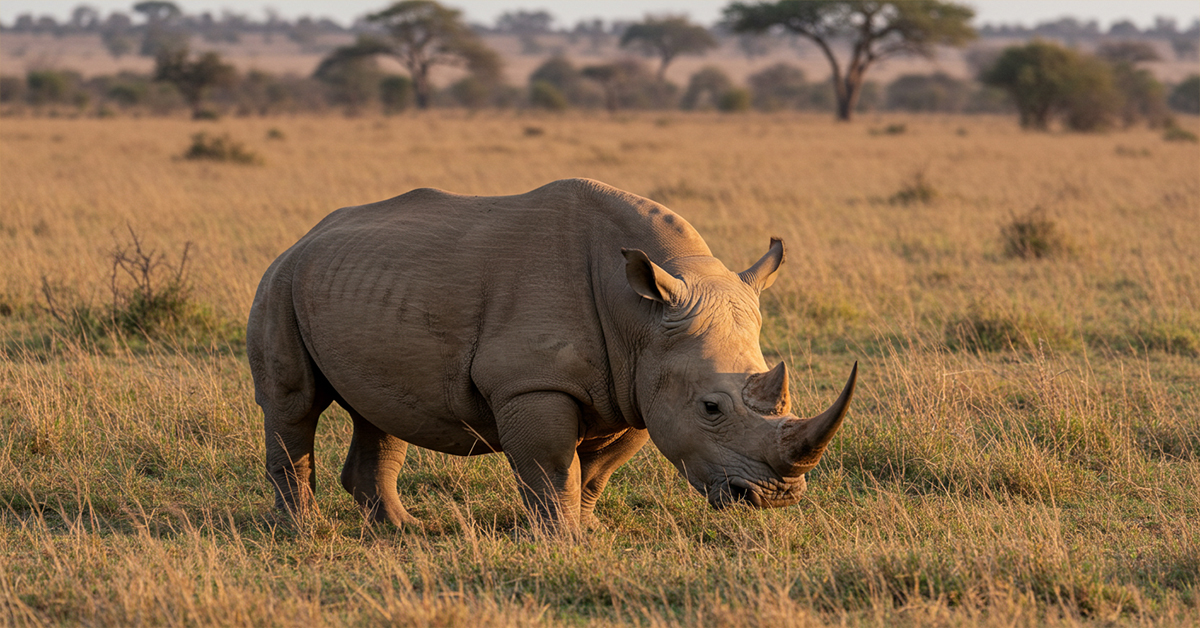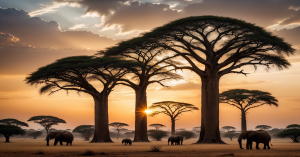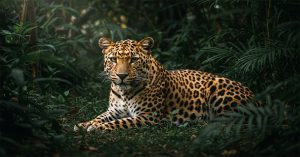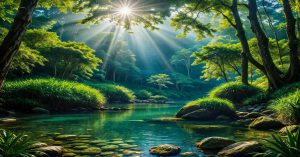Top 10 Rhino-Spotting Destinations Worldwide
Rhinos, with their imposing horns and prehistoric presence, are among the most majestic creatures on Earth. Yet, these gentle giants are often at risk, facing threats like poaching and habitat destruction.
Quick Facts About Rhinos
1. Ancient Giants: Rhinos have existed for about 50 million years, making them some of the oldest large mammals still on Earth.
2. Five Species: There are five species of rhinos: the Black Rhino, White Rhino, Indian Rhino, Javan Rhino, and Sumatran Rhino. Each has its unique features and habitats.
3. Horns of Keratin: A rhino’s horn is made of keratin, the same substance that makes up human hair and nails.
4. Poor Eyesight: Despite their size and strength, rhinos have relatively poor eyesight. They rely more on their sense of smell and hearing.
5. Speedy Sprinters: Rhinos can run at speeds of up to 55 km/h (34 mph) in short bursts when threatened.
6. Communication: Rhinos communicate through vocal sounds like snorts, grunts, growls, and trumpets, and even through their dung piles (middens).
7. Endangered Status: Sadly, all five species of rhinos are threatened, primarily due to poaching for their horns and habitat loss.
8. Mud Baths: Rhinos love wallowing in mud, which helps protect their skin from sunburn and parasites.
9. Solitary Lifestyle: Most rhino species prefer a solitary life, only coming together for mating or raising their young.
10. Tourism Hotspots: Major rhino habitats, such as the Serengeti in Tanzania, Kruger National Park in South Africa, and Chitwan National Park in Nepal, are popular tourist destinations.
Rhino safari not only offers an unforgettable experience for wildlife enthusiasts but also plays a vital role in their conservation. This guide takes you through the top 10 destinations worldwide where you can witness rhinos in their natural habitat.
1. Kruger National Park, South Africa
Kruger National Park, a jewel in South Africa’s conservation crown, is one of the best places to spot rhinos. It is home to both black and white rhinos, with populations thriving in the vast savannah and woodlands.
• Best Time to Visit: May to September, during the dry season, when animals congregate around water sources.
• What to Expect: Guided jeep safaris offer an up-close view of rhinos, while night safaris provide a chance to see these animals in a different light.
• Conservation Highlights: Kruger has pioneered anti-poaching measures and community programs, making it a global leader in wildlife protection.
• Recommended Lodges:
Sabi Sabi Earth Lodge – Luxury accommodation with excellent safari options.
Skukuza Rest Camp – Budget-friendly option with basic amenities and proximity to wildlife.
Lion Sands Game Reserve – Exclusive lodges with private rhino-spotting safaris.
2. Chitwan National Park, Nepal
Nestled in the foothills of the Himalayas, Chitwan National Park is a UNESCO World Heritage Site and a haven for the endangered one-horned rhinoceros.
• What Makes It Unique: This park offers a blend of rhino spotting with a taste of Nepalese culture. Canoe rides, jungle walks, and jeep safaris are popular.
• Best Time to Visit: October to March, during the cooler dry season for better wildlife visibility
• Conservation Efforts: Nepal’s success story in increasing rhino numbers through anti-poaching measures and community engagement is remarkable.
• Recommended Lodges:
Meghauli Serai, A Taj Safari Lodge – Luxurious riverside lodge with guided safaris.
Barahi Jungle Lodge – Eco-friendly lodging with canoe rides and safaris.
Jungle Villa Resort – Comfortable mid-range option near the park entrance.
3. Kaziranga National Park, India
Kaziranga, located in Assam, India, is a paradise for one-horned rhino enthusiasts. Its dense grasslands and marshy areas are the perfect habitat for these animals.
• Safari Experiences: Explore the park on jeep or elephant-back safaris. The latter provides a unique vantage point to observe rhinos.
• Best Time to Visit: November to April, during these months, the weather is mild and dry, making it ideal for wildlife safaris and outdoor.
• Flora and Fauna: In addition to rhinos, you can spot tigers, elephants, and a variety of bird species.
• Recommended Lodges:
IORA – The Retreat – Upscale resort with proximity to safari zones.
Diphlu River Lodge – Offers scenic views and intimate wildlife experiences.
Wild Grass Lodge – A charming and affordable stay for nature lovers.
4. Hluhluwe-Imfolozi Park, South Africa
The Hluhluwe-Imfolozi Park is steeped in history, known as the birthplace of modern rhino conservation. It played a pivotal role in saving the white rhino from extinction.
• What to See: Both black and white rhinos roam this park, along with other members of the Big Five.
• Best Time to Visit: May to September (dry season) when wildlife is easier to spot.
• Visitor Tips: Opt for guided tours to learn about the park’s historic conservation milestones.
• Recommended Lodges:
Hilltop Camp – Popular for its location and breathtaking views.
Rhino Ridge Safari Lodge – Luxurious yet sustainable accommodation.
Mpila Camp – Budget-friendly, self-catering accommodation within the park.
5. Ngorongoro Conservation Area, Tanzania
The Ngorongoro Conservation Area, a UNESCO World Heritage Site, is a breathtaking destination that combines dramatic landscapes with rich biodiversity. Known for the Ngorongoro Crater, it’s an exceptional spot to see rhinos in their natural habitat alongside other members of the Big Five.
• Why Visit for Rhinos: The crater’s unique environment supports a small population of critically endangered black rhinos. Spotting these majestic creatures against the backdrop of the crater’s lush grasslands and forests is a truly unforgettable experience.
• Safari Highlights: Rhinos can often be seen grazing on the crater floor, along with herds of elephants, lions, and wildebeests. Guided safaris provide an immersive way to explore this natural wonder.
• Best Time to Visit:
June to October (dry season) is ideal for wildlife viewing, as animals are easier to spot. However, the green season (November to May) offers lush scenery and fewer crowds, making it a great time for photography enthusiasts.
• Recommended Lodges:
Ngorongoro Crater Lodge – Ultra-luxurious lodge offering panoramic views of the crater and tailored safari experiences.
Rhino Lodge – Budget-friendly, eco-conscious accommodation close to the crater rim.
Entamanu Ngorongoro – A stylish and intimate lodge that blends luxury with sustainability.
6. Etosha National Park, Namibia
Etosha National Park in Namibia is a remarkable destination, where the stark beauty of the desert meets abundant wildlife. Known for its salt pans that stretch endlessly, the park provides an incredible setting to observe both black and white rhinos.
• Unique Landscape: The dry, open terrain makes it easier to spot wildlife, especially at waterholes where rhinos frequently gather.
• Best Time to Visit: May to October (dry season) when animals are concentrated around waterholes.
• Best Viewing Times: Late afternoons and early mornings are ideal for rhino spotting.
• Night Safaris: Etosha offers exceptional night-time viewing opportunities at floodlit waterholes, giving visitors a chance to see nocturnal activity, including rhinos in their natural behavior.
• Recommended Lodges:
Ongava Lodge – Luxurious private game reserve near the park.
Okaukuejo Camp – Famous for its floodlit waterhole for night-time wildlife viewing.
Mushara Lodge – Stylish and comfortable stay near the eastern gate of the park.
7. Ziwa Rhino Sanctuary, Uganda
Ziwa Rhino Sanctuary is a standout location for those keen on rhino tracking on foot. This sanctuary is dedicated to the reintroduction of rhinos in Uganda, making it a unique conservation hotspot.
• Walking Safaris: Guided walks with experienced rangers allow you to get close to rhinos safely.
• Biodiversity: Besides rhinos, Ziwa is home to over 300 bird species, making it a haven for birdwatchers as well.
• Connection to the Big Five: As part of Uganda’s Big Five initiative, Ziwa plays a critical role in boosting the country’s eco-tourism.
• Best Time to Visit: December to February and June to September for favorable weather and rhino tracking.
• Recommended Lodges:
Amuka Lodge – Cozy and eco-friendly with easy access to the sanctuary.
Ziwa Guesthouse – Affordable option for visitors keen on rhino tracking.
Kabalega Resort – Comfortable accommodations near the sanctuary.
8. Lake Nakuru National Park, Kenya
Lake Nakuru National Park is a stunning destination known for its vibrant flamingo population and thriving rhino conservation efforts. Located in Kenya’s Great Rift Valley, it offers a picturesque backdrop for wildlife viewing.
• Rhino Sanctuary: The park hosts both black and white rhinos, with significant conservation programs protecting their habitat.
• Spectacular Scenery: The combination of rhinos grazing along the lakeshore with pink flamingos in the background creates an unforgettable visual experience.
• Best Time to Visit: June to February, avoiding heavy rains for better wildlife spotting.
• Tourist Activities: Game drives, birdwatching, and photography are popular activities.
• Recommended Lodges:
Sarova Lion Hill Game Lodge – Overlooking Lake Nakuru with excellent services.
Lake Nakuru Lodge – Comfortable and family-friendly accommodation.
Flamingo Hill Tented Camp – A rustic yet luxurious tented experience.
9. Okavango Delta, Botswana
The Okavango Delta is one of the most biodiverse places in Africa, and a prime destination for rhino enthusiasts. The delta’s waterways and islands offer a unique safari experience.
• Diverse Wildlife: Both black and white rhinos are found here, alongside elephants, hippos, and predators like lions and leopards.
• Luxury Safaris: Visitors can enjoy exclusive, eco-friendly lodges and tailored safari experiences.
• Best Time to Visit: May to September (dry season) during the Okavango’s annual flood, making it perfect for safaris.
• Conservation Success: Reintroduction projects have helped bolster rhino populations in the delta.
• Recommended Lodges:
Mombo Camp – Ultra-luxurious camp offering exclusive wildlife experiences.
Vumbura Plains Camp – Modern and eco-friendly with a focus on luxury.
Xudum Okavango Delta Lodge – A serene lodge blending seamlessly with nature.
10. Ujung Kulon National Park, Indonesia
Ujung Kulon National Park is the last refuge of the critically endangered Javan rhino. Located on the western tip of Java, this park is an extraordinary destination for eco-tourists seeking to glimpse this elusive species.
• Elusive Nature: Spotting a Javan rhino is a rare and treasured experience due to its low population and secretive habits.
• Preservation Efforts: Strict conservation measures ensure the survival of this rhino species, making tourism highly regulated and eco-friendly.
• Activities: Trekking, guided tours, and exploring pristine rainforests are some of the activities offered to visitors.
• Best Time to Visit: April to September (dry season), when the trails are accessible, and weather conditions are favourable.
• Recommended Lodges:
Peucang Island Eco-Resort – Sustainable and close to the park’s attractions.
Taman Nasional Ujung Kulon Homestay – Budget-friendly with local hospitality.
Ratu Bagus Guesthouse – Simple accommodations near park access points.
Conservation Challenges and Success Stories
Rhinos face numerous challenges, primarily from poaching for their horns and habitat loss due to human activities. However, the commitment of global conservation organizations has led to several success stories:
• Anti-Poaching Measures: Enhanced security, ranger training, and community involvement have significantly reduced poaching in many regions.
• Community Engagement: In areas like Nepal and South Africa, local communities play a pivotal role in protecting rhinos while benefiting from eco-tourism.
• Breeding Programs: Sanctuaries and parks have implemented breeding programs to boost rhino populations.
Tips for Responsible Rhino Tourism
When embarking on a rhino-spotting journey, responsible tourism practices are crucial to ensure these majestic animals remain for future generations to admire.
• Choose Ethical Operators: Select safari operators that prioritize wildlife conservation and contribute to local communities.
• Respect Wildlife: Maintain a safe distance, avoid loud noises, and never feed animals.
• Support Conservation: Donate to conservation organizations or parks, and avoid purchasing products derived from rhino parts.
Final Thoughts
Rhino spotting is more than just a thrilling wildlife experience—it’s a step towards understanding and supporting conservation efforts for these magnificent creatures. From the savannas of Africa to the jungles of Asia, the top 10 destinations for rhino tourism offer an unforgettable journey into nature’s wild heart. By choosing responsible tourism, you can help ensure that rhinos continue to roam free for generations to come.
FAQs
1. What are the best months for rhino spotting in Africa?
The dry season (May to September) is ideal as wildlife congregates around waterholes, making them easier to spot.
2. Can I see rhinos in the wild in Asia?
Yes, parks like Chitwan National Park in Nepal and Kaziranga National Park in India are renowned for their one-horned rhinos.
3. How do national parks protect rhinos from poachers?
Parks implement anti-poaching patrols, use technology like drones, and engage local communities in conservation efforts.
4. Are walking tours safe for rhino spotting?
Walking tours, guided by experienced rangers, are generally safe and offer a unique way to observe rhinos in their habitat.
5. How can tourists support rhino conservation?
Tourists can support by visiting ethical operators, donating to conservation programs, and spreading awareness about rhino preservation.




